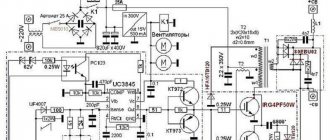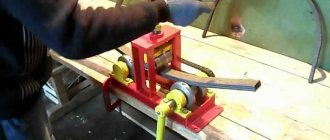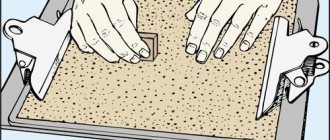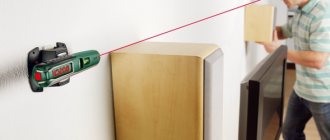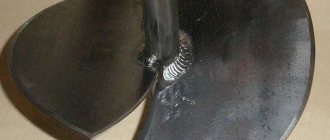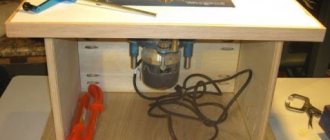In general, take scissors and cut along the path above the inscription “830B.4C”. Then you will need to restore just one connection using jumper AA and use the second jumper BB to indicate how to display commas on the screen. See further:
Comma management
| 1. jumper from “BATT +” (top pin R8) to bottom pin R2. The result will be like this: |
| 2. jumper from “BATT +” (top pin R8) to bottom pin R3. The result will be like this: |
| 3. jumper from “BATT +” (top pin R8) to bottom pin R4. The result will be like this: |
| 4. If the jumper is not installed at all, the “HV” icon will not be displayed. |
As you can see, commas are very easy to manage.
At least a switch (if necessary, of course). In its original case, the resulting “multimeter stub” now looks like this:
Divider for voltmeter
There are unused precision resistors left on the sides of the board - they can be used to organize the desired voltage divider for a voltmeter:
| position | denomination | divider | range 1 (voltmeter input resistance) | range 2 (voltmeter input resistance) |
| R22 | 100 | 1:1 | 0 - 200 mV / 0.1 kOhm | not Spanish |
| R21 | 900 | 1:10 | 0 - 2 V / 1 kOhm | 0 - 200 mV / 1 kOhm |
| R13 | 9k | 1:100 | 0 - 20 V / 10 kOhm | 0 - 2 V / 10 kOhm |
| R14 | 90k | 1:1000 HV | 0 - 200 V / 100 kOhm | 0 - 20V / 100 kOhm |
In order to use the divider, you need to connect the lower pin R22 to the “COM” bus (for example: the upper pin C3 or the lower pin R7). Connect the input of the microcircuit to the desired divider tap (connect the upper pin R6 to the lower pin R21 if range 1 is selected or to the upper pin R21 if range 2 is selected). The difference in the choice of ranges will be in the input resistance of the resulting voltmeter. Resistors R1 100 Ohm and R2 900 Ohm cannot be touched, they are used. Resistor R9 is not used. It can even be removed; but you can't connect to it.
What happened as a result
In essence, it turned out to be a measuring head, also known as a digital DC voltmeter, with the following parameters:
- input voltage range -199-0-199 mV (both polarities are measured with sign indication);
- overload indication;
- linearity error no more than ±0.2 units;
- zero setting error no more than ±0.2 units;
- input current no more than 1pA (typical value for ICL7106/7107), corresponding to the input resistance guaranteed to be hundreds of megaohms;
- The current consumption of the voltmeter is about 1 mA on each arm, which corresponds to hundreds of hours of operating time from the standard “Krona”.
- The low-pass filter at the input (R6 1Mohm and C3 0.1uF) provides a settling time of 0.1 sec.
Now all that remains is to carefully file the case around the perimeter of the board - and you can insert it somewhere.
If you want to completely abandon the original plastic case, you only need to ensure good electrical contact of the display contact pad through the strip of conductive rubber used in the multimeter. You can't solder wiring to glass. If you need to power the voltmeter from the device where it will be installed, you should take into account that the voltage at the “BATT+” pin of the microcircuit (relative to “COM”, of course) will always be 3.0V because it is stabilized by the internal reference stabilizer in the microcircuit itself and cannot be exceeded; the negative voltage “BATT-” is formed as the voltage on the battery minus 3.0V. Both voltages can be formed by parametric stabilizers using two resistors and any zener diode, even a green one or, better yet, a white LED. But the best thing is to provide a galvanically independent power source for the voltmeter, especially since the current consumption is negligible.
Application
Thermometer -55…+150С with resolution 0.1С
As a sensor we use the LM35 sensor chip in the following configuration:
The approximate price of the chip is about 200 rubles ($6) for LM35CZ.
Schematic diagram of a thermometer
Operating temperature range, error and chip index
| marking* | temperature range | typical error at 25C** | TO-46 body | TO-92 body | SO-8 housing (SMD) | housing TO-220 |
| LM35 | -55…+155 | 0.4 | LM35H | |||
| LM35A | -55…+155 | 0.2 | LM35AH | |||
| LM35C | -40…+110 | 0.4 | LM35CH | LM35CZ | ||
| LM35CA | -40…+110 | 0.2 | LM35CAH | LM35CAZ | ||
| LM35D | 0…+100 | 0.4 | LM35DH | LM35DZ | LM35DM | LM35DT |
Note:
*A index means improved accuracy and linearity. **at the edges of the range the error is approximately 2 times higher, for more details see
I received from AliExpress a couple of electronic built-in voltmeters model V20D-2P-1.1 (DC voltage measurement), the price is 91 cents each. In principle, you can now find it cheaper (if you look hard enough), but it’s not a fact that this will not be to the detriment of the build quality of the device. Here are its characteristics:
- operating range 2.5 V - 30 V
- glow color red
- overall size 23 * 15 * 10 mm
- does not require additional power (two-wire version)
- there is a possibility of adjustment
- refresh rate: about 500ms/time
- Promised measurement accuracy: 1% (+/-1 digit)
And everything would be fine, put it in place and use it, but I came across information about the possibility of improving them - adding a current measurement function.
Digital Chinese voltmeter
I prepared everything I needed: a two-pole toggle switch, output resistors - one MLT-1 for 130 kOhm and a second wire resistor for 0.08 Ohm (made from a nichrome spiral with a diameter of 0.7 mm). And the whole evening, according to the found circuit and instructions for its implementation, I connected this equipment with wires to a voltmeter. To no avail. Either there was not enough insight in understanding what was left unsaid and incompletely drawn in the material found, or there were differences in the schemes. The voltmeter didn't work at all.
Connecting the digital voltmeter module
I had to unsolder the indicator and study the circuit. What was needed here was not a small soldering iron, but a tiny one, so it took quite a bit of fiddling. But over the next five minutes, when the entire scheme became available for review, I understood everything. In principle, I knew that this was where I needed to start, but I really wanted to solve the issue “easy.”
V-meter modification scheme
Revision scheme: ammeter to voltmeter
This is how this scheme for connecting additional electronic components with those already existing in the voltmeter circuit was born. The standard resistor of the circuit marked in blue must be removed. I’ll say right away that I found differences from other circuits given on the Internet, for example, the connection of a tuning resistor. I didn’t redraw the entire voltmeter circuit (I’m not going to repeat it), I only drew the part that was necessary for modification. I think it’s obvious that the voltmeter’s power supply needs to be separate; after all, the starting point in the readings should start from zero. Later it turned out that power from a battery or accumulator will not work, because the current consumption of the voltmeter at a voltage of 5 volts is 30 mA.
Board - Chinese voltmeter module
After assembling the voltmeter, I got down to the essence of the action. I won’t split hairs, I’ll just show and tell you what to connect with what to make it work.
Step-by-step instruction
So
,
step one
- an SMD resistor with a resistance of 130 kOhm is removed from the circuit, standing at the input of the positive power wire, between the diode and the trimming resistor 20 kOhm.
We connect the resistor to the voltmeter-ammeter
Second
.
On the free contact, on the side of the trimmer, a wire of the desired length is soldered (for testing, 150 mm is convenient and preferably red) Solder the SMD resistor
Third
. A second wire (for example, blue) is soldered to the track connecting the 12 kOhm resistor and the capacitor from the “ground” side.
How to choose a shunt for an ammeter as accurately as possible?
For the resistance selection stand we will need:
- power unit;
- exemplary device;
- high-quality wires (copper);
- variable resistance;
- the shunt itself and the ammeter for which it is being prepared.
The circuit is needed to accurately select the shunt resistance and calibrate the device with the installed pad.
Having set the minimum and maximum values under load (battery charge), we begin to stepwise change the current strength with variable resistance. The values obtained on the control device are plotted on the scale.
Let's remember physics. Video lesson on calculating a shunt for an ammeter.
Source: obinstrumente.ru
Testing a new circuit
Now, according to the diagram and this photo, we “hang” an addition to the voltmeter: a toggle switch, a fuse and two resistors. The main thing here is to correctly solder the newly installed red and blue wires, however, not only them.
We convert the voltmeter block into an A-meter
But here there are more wires, although everything is simple:
" - a pair of connecting wires is connected to the electric motor "
separate power supply for the voltmeter
" - a battery with two more wires "
power supply output
" - a couple more wires
After applying power to the voltmeter, “0.01” was immediately displayed; after applying power to the electric motor, the meter in voltmeter mode showed a voltage at the output of the power supply equal to 7 volts, then switched to ammeter mode. The switching was performed when the power supply to the load was turned off. In the future, instead of a toggle switch, I will install a button without locking, it will be safer for the circuit and more convenient for operation. I was pleased that everything worked on the first try. However, the ammeter readings differed from the multimeter readings by more than 7 times.
Chinese voltmeter - ammeter after modification
Here it turned out that the wirewound resistor, instead of the recommended resistance of 0.08 Ohm, has 0.8 Ohm. I made a mistake in the measurements during its manufacture in the counting of zeros. I got out of the situation like this: the crocodile with the negative wire from the load (both black) moved along a straightened nichrome spiral towards the input from the power supply, the moment when the readings of the multimeter and the now modified ampere-voltmeter coincided and became the moment of truth. The resistance of the involved section of the nichrome wire was 0.21 Ohm (measured with a multimeter attachment at the “2 Ohm” limit). So it didn’t even turn out bad that instead of 0.08 the resistor turned out to be 0.8 Ohm. Here, no matter how you count, according to the formulas, you still have to adjust. For clarity, I recorded the result of my efforts on a video.
How to calculate a shunt for an ammeter?
- Calculation of the shunt for a slight expansion of the upper limit of the ammeter scale. The shunt resistance is calculated using the formula. Rsh = (Ra * Ia)/(I - Ia) Rsh is the resistance that the shunt must have. Ra is the internal resistance of the ammeter without load. I is the expected current at which the instrument pointer takes the maximum position at the end of the scale. Ia is the current at which the instrument pointer takes the extreme position at the end of the scale without using a shunt. The resistance value is calculated by the formula in Ohms, the current in Amperes.
- Calculation of a shunt for an ammeter when the measurement limit is significantly exceeded. The shunt resistance is calculated using the formula. Rsh = (Ra * Ia)/I
Video
I consider the purchase of these voltmeters a success, but it’s just a pity that their current price in that store has increased significantly, almost 3 dollars apiece. Author Babay iz Barnaula.
A miniature Chinese voltmeter can simplify the process of measuring voltage and the amount of current consumed on a power supply or homemade charger. Its cost rarely exceeds 200 rubles, and if you order it from China through affiliate programs, you can also get a significant discount.
Why can’t one device measure a wide range of quantities?
The operating principle of any ammeter (pointer or coil) is based on converting the measured value into its visual display. Pointer systems operate on a mechanical principle.
A current of a certain magnitude flows through the winding, causing it to deflect in the field of a permanent magnet. There is an arrow attached to the reel. The rest is a matter of technique. Scale, markings, etc.
The dependence of the deflection angle on the current strength on the coil is not always linear; this is often compensated by a specially shaped spring.
To ensure measurement accuracy, the scale is made with as many intermediate divisions as possible. In this case, to ensure a wide measurement range, the scale must be of enormous size.
Or you need to have several instruments in your arsenal: an ammeter for tens and hundreds of amperes, a regular ammeter, a milliammeter.
In digital multimeters the picture is similar. The more accurate the scale, the lower the measurement limit. And vice versa - an overestimated value of the limit gives a large error.
A scale that is too busy is inconvenient to use. A large number of positions complicate the design of the device and increase the likelihood of loss of contact.
By applying Ohm's law to a section of the circuit, you can change the sensitivity of the device by installing a shunt for the ammeter.
Help: A shunt is a bypass resistance, a conductor connected parallel to the measured section of the circuit. Part of the current bypasses the main section, and less load falls on the connected device.
Let's start our study with theory:
To charger
Those who like to design their own chargers will appreciate the ability to monitor the volts and amperes of the network, without the help of bulky portable devices. This will also appeal to those who work on expensive equipment, the operation of which can be adversely affected by regular drops in network voltage.
Using a Chinese ampere-voltmeter, which is no larger than a box of matches, you can easily monitor the state of the electrical network. One of the tangible problems that new electricians have may be the language barrier and wire markings that differ from the standard ones. Not everyone will immediately understand which wire needs to be connected where, and the instructions are usually only in Chinese.
100 V/10 A devices are very popular among independent designers. It is also desirable that the device have a shunt to finalize the connection process. A tangible advantage of this device is that it can be connected to a charger power source or to a separate battery.
*The power supply voltage of the ammeter and voltmeter must be in the range from 4.5 to 30 V.
The connection diagram is as follows:
- The black wire is negative. It also needs to be connected to minus.
- The red wire, which should be thicker than the black one, is a plus, and accordingly must be connected to the power source.
- The blue wire connects the load to the network.
If everything has been connected correctly, two scales should light up on the display.
Useful tips
If a home electrician decides to purchase a commercially available ammeter, he should choose one with a fine calibration because it will be more accurate. Then, perhaps, you won’t need a homemade shunt.
When working with the tester, you should follow basic safety precautions. This will help prevent serious injury caused by electrical shock.
If the tester systematically goes off scale, you should not use it.
It is possible that the device is either faulty or is not able to show the correct measurement result without additional equipment. It is best to purchase modern domestically produced ammeters, because they are better suited for testing new generation electrical appliances. Before you start working with the tester, you should carefully read the operating instructions.
A shunt is a great way to optimize the home electrician's job of testing electrical circuits. In order to make this device with your own hands, you will only need a working industrial production tester, available materials and basic knowledge in the field of electrical engineering.
Source: obinstrumentah.info
To power supply
Power supplies play an important role in leveling the network readings to the desired state. If not operated correctly, they can cause serious damage to expensive equipment by causing overheating. In order to avoid problems during their operation, and especially in cases where the power supply is made manually, it is advisable to use an inexpensive ammeter and voltmeter.
You can order a variety of models from China, but for standard devices operating from a home network, those that measure current from zero to 20 A and voltage up to 220 V are suitable. Almost all of them are small-sized and can be installed in small power supply cases.
Most devices can be adjusted using built-in resistors. In addition, they have high accuracy, almost 99%. The display displays six positions, three each for voltage and current. They can be powered either from a separate or built-in source.
To connect a voltmeter you need to understand the wires, there are five of them:
- Three thin ones. Black minus, red plus, yellow to measure the difference.
- Two fat ones. Red plus, black minus.
The first three cords are most often combined for convenience. The connection can be made through a special socket connector, or using soldering.
*A connection by soldering is more reliable; with minor vibrations, the socket mount of the device may become loose.
Step-by-step connection:
- It is necessary to decide from which power source the device will operate, separate or built-in.
- The black wires are connected and soldered to the minus of the power supply. Thus, a general minus is created.
- In the same way, you need to connect the thin red and yellow contacts. They are connected to the power contact.
- The remaining red pin will connect to the electrical load.
If the connection is incorrect, the device display will show zero values. In order for the measurements to be as close as possible to the actual ones, it is necessary to correctly observe the polarity of the supply contacts. Only connecting a thick red wire to the load will give an acceptable result.
Note! Accurate voltage values can only be obtained with a regulated power supply. In other cases, the display will only show the voltage drop.
A popular voltmeter model that is often used by radio amateurs. Has the following characteristics:
- Operating voltage DC from 4.5 to 30 V.
- Power consumption less than 20 mA.
- The display is two-color red and blue. Resolution 0.28 inches.
- Performs measurements in the range 0 – 100 V, 0 – 10 A.
- The lower limit is 0.1 V and 0.01 A.
- Error 1%.
- Temperature operating conditions from -15 to 75 degrees Celsius.
Connection
Using a voltmeter, you can measure the current voltage in the power supply network. To do this, you need the following:
- Connect the thick black wire to the negative of the power supply.
- Red connects to the load, and then to the power.
This connection diagram does not provide for the use of a thin black contact.
If a third-party power source is used, the connection will be as follows:
- Thick cords are connected in the same way as in the previous example.
- Thin red connects to the plus of a third-party source.
- Black with a minus.
- Yellow with source plus.
This voltmeter and ammeter is also convenient because it is sold in an already calibrated state. But even if inaccuracies in its operation were noticed, they can be corrected using two tuning resistors on the rear panel of the device.
Shunt for an ammeter - how to make it yourself, calibrate and expand the capabilities of the tester
Measuring current is a fairly important procedure for calculating and testing electrical circuits. If you are creating a device with power consumption at the level of charging a mobile phone, a regular multimeter is enough to measure.
A typical inexpensive household tester has a current measurement limit of 10 A.
Most of these devices have an additional connector for measuring larger quantities. When rearranging the measuring cable, you probably haven’t thought about why you need to organize an additional circuit, and why you can’t just use the mode switch?
Which digital voltmeters are the most reliable?
The electrical equipment market is crowded with manufacturers who provide a wide variety of choices. However, not every device brings positive emotions from use. With a large number of products, it is not always possible to find a reliable and inexpensive copy.
Tested and reliable voltmeters include:
- TK 1382. Inexpensive Chinese, the average price of which rarely rises above 300 rubles. Equipped with tuning resistors. Performs measurements in the ranges 0-100 Volts, 0-10 Amps.
- YB27VA. Almost a twin of the previous voltmeter, it differs in the marking of the wires and at a reduced price.
- BY42A. It is more expensive than previous models, but also has an increased upper measurement limit of 200 V.
These are the most popular representatives of this type of voltmeters, which can be freely purchased for conversion on the radio market or ordered via the Internet.
